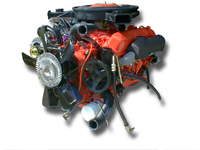|

The first 383 was introduced in 1959, but as the raised block. The dimensions on this engine were a bore of 4.030 and a stroke of 3.750 inches. This engine was available with two four-barrel induction and a horsepower rating of 345 @ 5000 rpm. The following year retained the raised block status of the 383, but introduced the outrageous long ram aluminum manifolds. There is some confusion over the long and short terms and the availability. The manifolds were dimensionally identical. The difference is internal. In the long ram, the Siamese tubes are separated by a continuous wall, the entire length of the runners. In the short ram, the term short refers to the divider wall, which extends only 10 1/2 inches from the cylinder head surface. In other words, the terms long and short refer to the divider wall, and not the length of the tubes. All passenger cars had the long ram configuration. The short ram was available over the parts counter. The long rams were for low and mid-range RPM applications and the short ram was strictly high RPM and performance on the track. This system was offered again in 1961. Let's take a look at the numbers. The long ram 383 produced 330 horsepower at 4800 rpm, with a torque reading of 460 ft. pounds at only 2800 rpm. The short ram 383's numbers are 340 horsepower at 5000 rpm, with a torque reading of 440 ft. pounds @ 2800 rpm. The differences are minor, but the driveability was major.
The 383 was converted to a low deck configuration in 1960. It was now a 4.250 bore with a 3.380 stroke. The highest horsepower 383 featured the 300J heads, with two four-barrel induction, and a horsepower rating of 343 hp. This combination was offered primarily in the big cars, but was available over the counter through 1962. There is an NHRA class engine for the 1962 B-body Plymouth and Dodge listed in the 1962 rule book for this application. Research into this engine has shown that the 1962 B-bodies with this option were ordered as 383 four-barrel cars, with the induction system (manifold, carbs, linkage, and football shaped air cleaners shipped in the trunk) dealer installed.
The 383 remained a strong performer through the mid 60's, but the performance image had shifted to the 413 and 426 wedge and max wedge programs. The incredible 426 Hemi was on the horizon, but the low deck engines were far from the scrap heap.

The advertised horsepower ratings of the 383 were actually lowered in the mid 60's, in order to highlight the performance aspect of the RB engines. The late 60's performance spotlight returned to the 383, with the introduction of the Plymouth Roadrunner and Dodge Superbee. The 1967 year is very significant in the development of the 383 as an image engine. This is when the high performance 440 was introduced in the first badge identified B-bodied performance cars. The GTX and the R/T featured the high compression, big valved, hot cammed, dual exhaust, unsilenced air cleaner, 375 horsepower earth-moving 440 HP. The market in 1968 demanded an affordable musclecar. The hot 440 parts would bolt right on the 383, and Chrysler had built millions of them. Cheap to produce, bullet-proof, and possessing outstanding performance, the 383 embarrassed a lot of 440 owners. The short stroke engine with the proper gearing was a performance and sales success.
The 383 was gradually detuned, as all smog motors were, and in 1972 it was replaced with the huge bore (4.340) 400. Do not overlook this engine as a performer. Think of it as a big 383. Lots of cubic inches in a relatively small package. Lots of options on the performance list. There were over 3 million 383's produced through 1971 and they are still relatively easy to find. The 400 blocks are very common and will bolt in anywhere there was a big block engine. The 400 is externally balanced and requires the correct damper and torque converter.
|